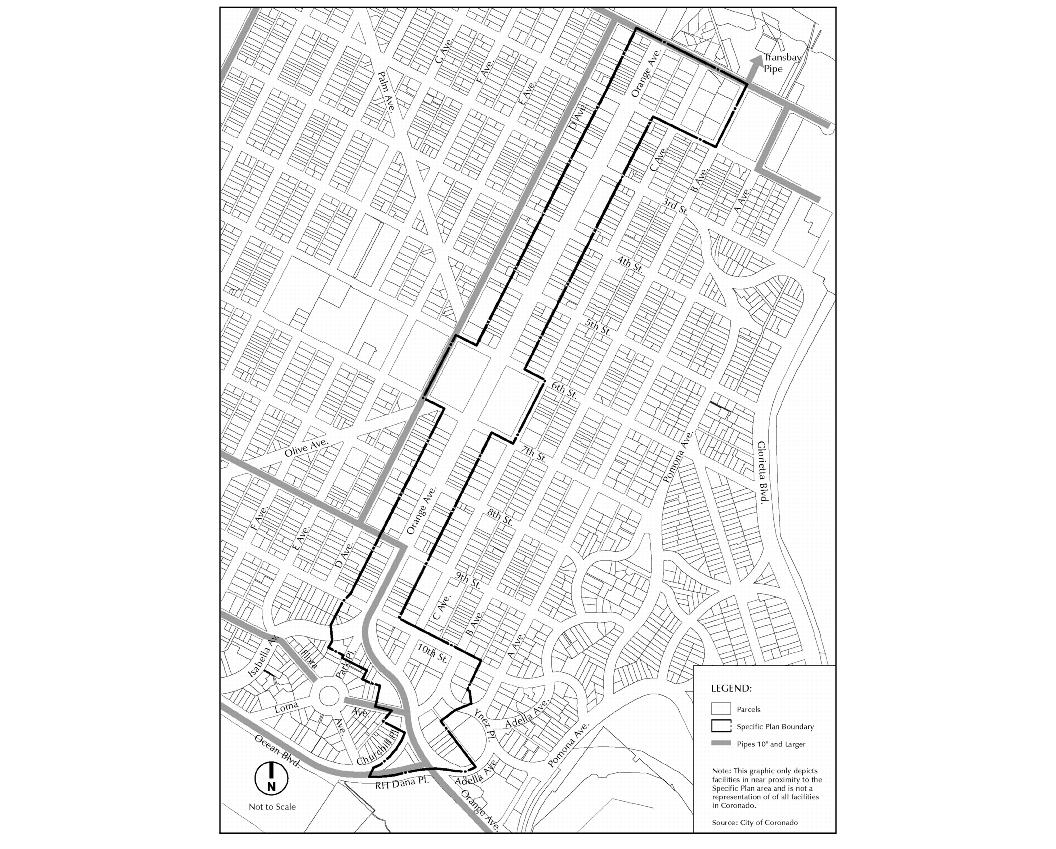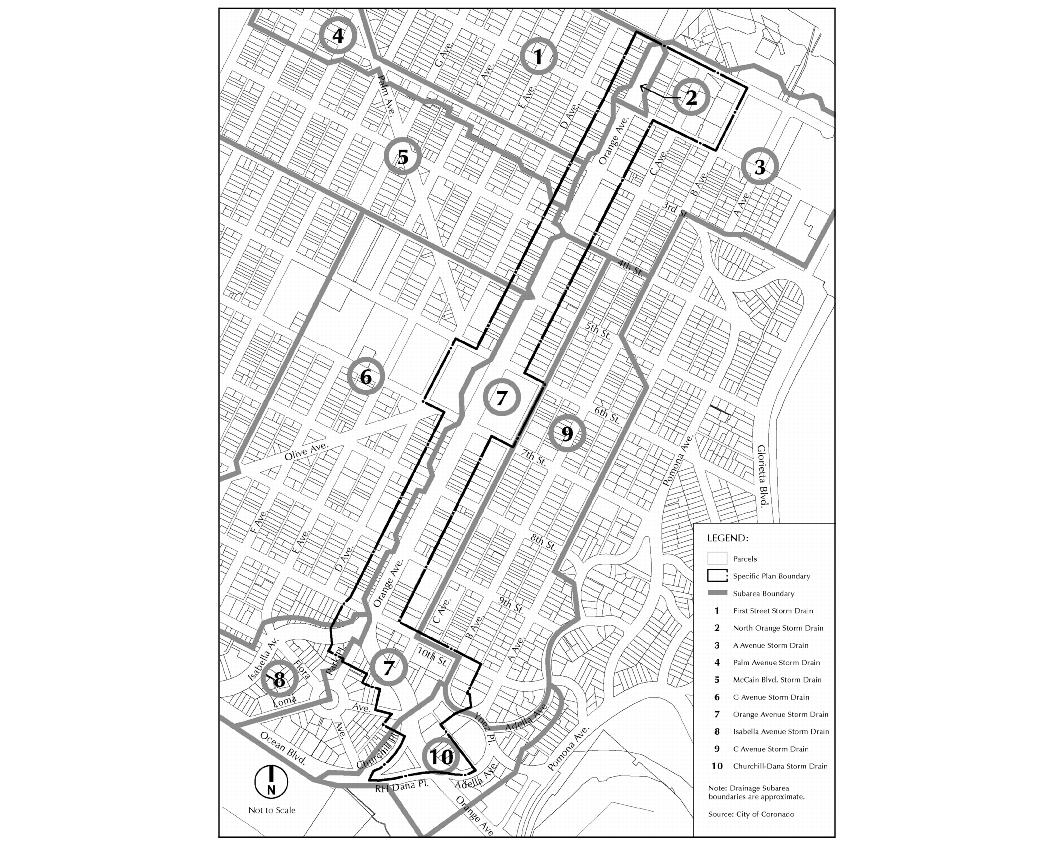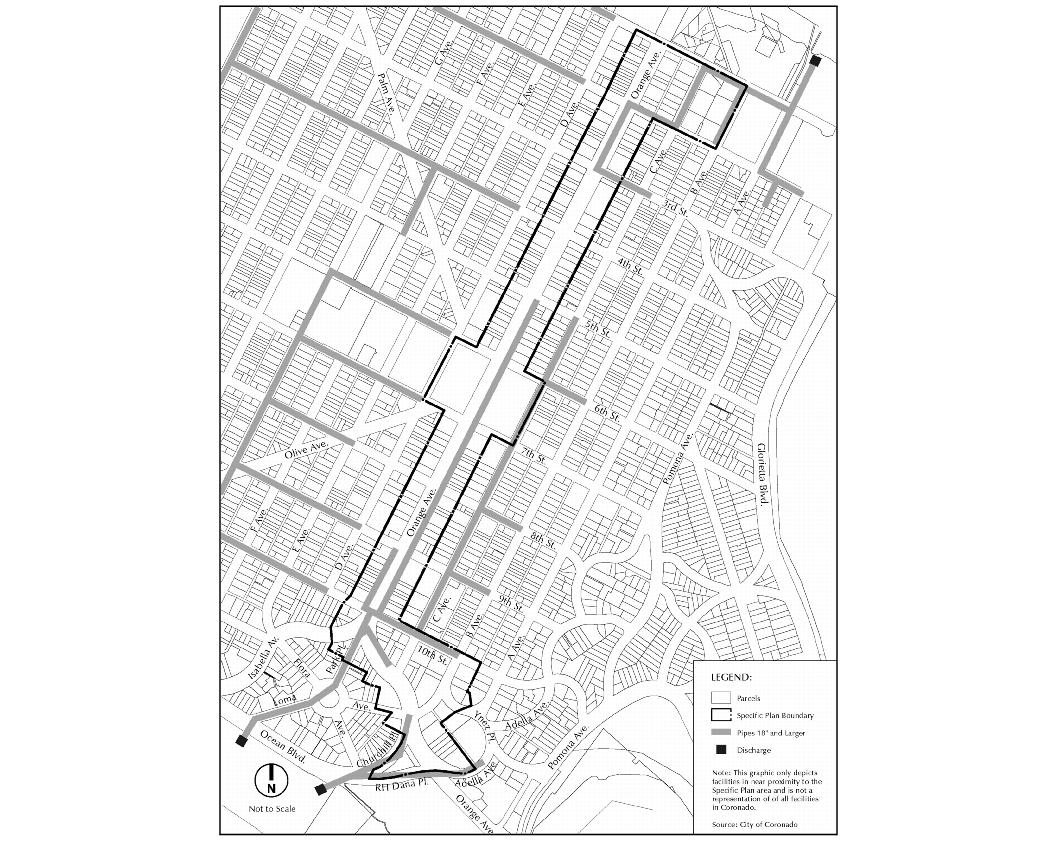Chapter IX
INFRASTRUCTURE
A. INTRODUCTION
Utility service infrastructure such as water, wastewater, and storm drainage facilities are essential services and allow for the orderly growth and redevelopment of a community.
Per the City’s 1986 General Plan, service infrastructure for City of Coronado has been found satisfactory to accommodate the General Plan land uses and intensity of use. The Specific Plan area is largely built out and the Specific Plan does not increase residential density or commercial floor area nor does it intensify the land uses set out in the General Plan or the Zoning Ordinance; therefore, Coronado’s existing infrastructure framework is generally considered adequate to service the Specific Plan land uses.
For informational purposes these facilities are briefly discussed in this section of the Specific Plan.
B. WATER SERVICE
The City of Coronado obtains its domestic water from the California-American Water Company (the Company), whose primary supplier is the City of San Diego. The San Diego County Water Authority (CWA) supplies approximately 90 percent of San Diego’s water, imported from the Colorado River and the California Water Project, while the remaining 10 percent of the raw water supply comes from local reservoir systems owned and operated by the City of San Diego.
The Company service boundaries include the entire City of Coronado. Potable water is supplied by two trunk lines – one is a 24-inch transbay pipeline from San Diego that enters Coronado at First Street and A Avenue at the northeast end of the City, while the other is a 16-inch main that comes up the Strand from Imperial Beach. Additionally, a second 24-inch line under the bay from San Diego supplies North Island with water. The two 24-inch trunk lines are inter-connected for backup supply in the case of an emergency or other event that would cause one of the trunk lines to be out of service.
Since a facilities improvement program was completed in 1992, Coronado’s distribution system is free of main and service leaks, provides excellent water pressure, and is well maintained. The contract between the Company and the City of San Diego ensures that the Company has the right to purchase unlimited amounts of water for an indefinite period of time.
The 1986 Coronado General Plan Land Use Element states that the “water system is in excellent condition with no major deficiencies” and that “the overall flow rates and pressure are sufficient to accommodate the future growth projections for the community.” This Specific Plan does not propose any land use changes different from the General Plan land uses, which are also identical to the City’s zoning.
To conserve water, new development and redevelopment will comply with the applicable requirements of City of Coronado Municipal Code’s Title 64: Water Conservation. The section addresses low flow fixtures for residential development and low volume drip or bubble emitters for outside irrigation.
C. WASTEWATER SERVICE
The Specific Plan area lies entirely within the “Village” wastewater service area,” which is operated and maintained by City of Coronado’s Department of Public Services. Wastewater in the City flows northbound through gravity sewers from the Coronado Cays into the Village, and then flows by gravity and force to the Transbay Sewage Pump Station at the Old Ferry Landing. The Transbay Pump Station transfers all the liquid sanitary waste collected in the City through a 24-inch force main under San Diego Bay to the City of San Diego’s Point Loma Wastewater Treatment Plant (WWTP), where it is treated and then discharged through an ocean outfall located two miles offshore. Figure IX-1 shows wastewater conveyance pipes ten inches and larger within the Specific Plan area and its near vicinity.
The 1986 Coronado General Plan Land Use Element states that the “sanitary system is in good overall condition and of adequate capacity to serve the projected population and development growth anticipated over the next several years” and also states that the entire system should serve for at least the next 40 years based upon current information.”
City of Coronado’s Sewer Master Plan (Poutney & Associates, Inc. 2000) indicates that the Transbay Pump Station is at its current capacity, which is 12.1 million gallons per day (MGD), if certain scenarios are assumed regarding peak flows coming from other pump stations in Coronado. The 2000 Sewer Master Plan considered existing and future sewage flows based on existing land uses and future land uses on vacant lots and parking lots, based on existing zoning.
This Specific Plan does not propose any land use changes different from the General Plan land uses, which are also identical to the City’s zoning.
D. STORM DRAINAGE
Due to Coronado’s location and its relatively flat topography, most storm water runoff flows by gravity into either the Pacific Ocean or San Diego Bay. The average rainfall in the City is 8.1 inches. Localized street and residential and commercial flooding occurs approximately two to four times per year with moderately heavy rainfall in less than 10-year frequency storms.
City of Coronado’s Department of Public Services is responsible for the maintenance and operation of the storm drainage system within the City. Portions of the Specific Plan Area lie within the following storm drainage basins, as seen in Figure IX-2:
1. First Street Storm Drain
2. North Orange Storm Drain (entirely within the Specific Plan area)
3. A Avenue Storm Drain
4. Palm Avenue Storm Drain
5. McCain Boulevard Storm Drain
6. G Avenue Storm Drain
7. Orange Avenue Storm Drain (encompassing a significant portion of the Specific Plan area)
8. Isabella Avenue Storm Drain
9. C Avenue Storm Drain
10. Churchill-Dana Storm Drain
Storm drainage system pipes 18 inches and larger within the Specific Plan area and its near vicinity and storm water discharge points are shown on Figure IX-3.
According to the City’s adopted Master Plan of Drainage (Berryman & Stephenson, Inc. 1980), six of the Storm Drain subareas that are part of the Specific Plan area are identified as having major drainage defiencies:
1. First Street Storm Drain
2. A Avenue Storm Drain
3. McCain Boulevard Storm Drain
4. G Avenue Storm Drain
5. Orange Avenue Storm Drain (encompassing a significant portion of the Specific Plan area)
6. Isabella Avenue Storm Drain
The City’s Master Environmental Assessment (Harland Bartholomew & Associates, 1995) indicates that several recommended improvements have occurred or are proposed.
Private site development within the Specific Plan area would be designed to discharge into an approved storm drainage system as determined appropriate at the time of individual permitting. Individual projects must comply with Regional Water Quality Control Board Standards for discharge and pollutant runoff mitigation. All public right-of-way projects would need to be designed compatibly with existing and planned drainage systems and infrastructure.
Figure IX-1 Wastewater System
Figure IX-2 Storm Drainage Subareas
Figure IX-3 Storm Drainage System
E. SOLID WASTE
Solid waste is provided by the City of Coronado through a private waste collection service. It was estimated that the City disposes of approximately 18,000 tons of solid waste annually (Master Environmental Assessment, Harland Bartholomew & Associates, 1995.) Solid waste is disposed at the Otay landfill in the City of Chula Vista.
New development and redevelopment within the Specific Plan area should be conditioned to reduce solid waste generation by participating in available commercial and residential recycling programs.
In accordance with the provisions of the California Administrative Code, the design of any new, remodeled or expanded building or complex of buildings shall make provision for adequate storage and handling facilities which will accommodate the solid waste loading anticipated and which will allow for efficient and safe waste removal or collection. The design shall demonstrate that it includes the required provisions for storage capabilities and access to waste containers. Every new location for waste receptacles shall be screened by a wall or fence so that the receptacles are not visible from any adjacent street or property. (CAC Section 17313)
F. ENERGY
The City of Coronado obtains its energy supply of natural gas and electricity from the San Diego Gas & Electric Company (SDG&E.) SDG&E’s local substation has a capacity of approximately 90 MVA of firm capacity, with the ability to increase to 120 MVA. Natural gas is supplied to the City by two transbay gas mains. SDG&E is able to meet existing demands and per the Master Environmental Assessment (Harland Bartholomew & Associates, 1995) was analyzing the feasibility of another gas feeder system to improve service levels.
The City General Plan’s Conservation Element addresses the strategies for regional and local energy conservation and states that “the City Council has approved a number of...programs/policies that will reduce...energy consumption” and cites lack of an alternative efficient energy infrastructure.
The Specific Plan continues to promote and enhance the existing pattern of dense shopping and employment uses very close to residential areas, which conserves energy because people can use alternative modes of transportation, such as walking, bicycling, and the shuttle bus.
New development and redevelopment within the Specific Plan area are encouraged to use energy efficient designs and materials when possible, and to take advantage of any City programs to conserve energy.





